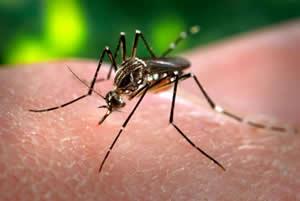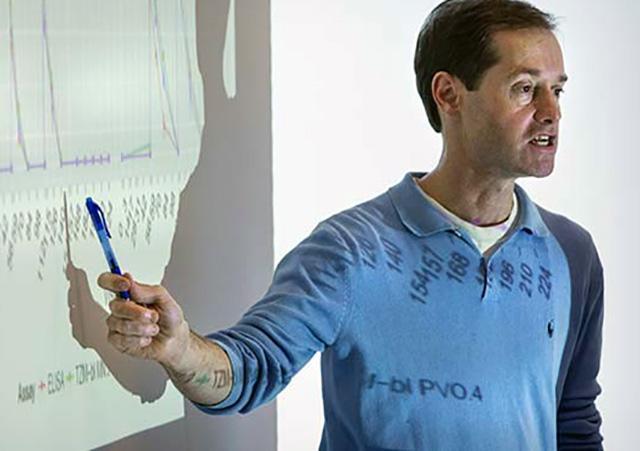Nearly half the world’s population is at risk for dengue and work to develop a more effective vaccine is complicated by the fact that there are four genetically diverse dengue serotypes.

A recently published paper reveals a new, innovative approach to dengue vaccine development. The study also sheds light on risks and issues that must be considered when developing vaccines for young children. The team of researchers features a number of UW Biostat graduates and faculty including Michal Juraska (MS ’09, PhD ’12), and UW Biostat Research Professor Peter Gilbert (BS ’92, MS ’94, PhD ’96) as well as David Benkeser (PhD, ’16), Jason Shao (MS, ’17), and affiliate assistant professor Paul Edlefsen. The team published its findings in the August 20 Proceedings of the National Academy of Sciences.
“In the past, vaccine development for dengue has focused on vaccines that represent all four different serotypes inside the vaccine, “said Gilbert. “Our focus was on the amino acid sequences and our goal was to see if vaccine efficacy depended on the protein sequences of these dengue viruses.”
Before analyzing the amino acid sequences, the team determined that vaccine efficacy to prevent dengue disease did differ by serotype. They found that vaccine efficacy was significantly greater against serotype 3 and 4 than against serotypes 1 and 2. Further exploration revealed that the viral strain for serotype 2 that was put in the vaccine was not well matched to the circulating serotype 2 viral strain, whereas, serotype 3 and 4 vaccine strains were better matched to the circulating viruses (match being defined by an amino acid protein distance).
“It’s the first time that anyone has really proved that you better take protein sequences seriously not just the serotypes,” said Gilbert. “We’re basically breaking the mold by saying it’s not that simple. You can’t just get these discrete, serological types. You have to deal with the dimensionality of the protein sequences. Distance matters, the farther away from the vaccine the worse the efficacy. Researchers need to try to bioinformatically optimize the strains put into the vaccine and make them as close in protein sequence to the circulating viruses as possible.”

The team’s other main finding involved vaccine efficacy in children. For context, Gilbert referred to a 2018 landmark study published in the New England Journal of Medicine that he also co-authored. That study showed that the current vaccine is effective if a person has already been exposed to dengue. However, for a person who has not been exposed, like a small child not yet infected through a mosquito bite, the vaccine actually increased the rate of hospitalization with dengue compared to placebo.
In the current analyses, the team discovered that in older children (9-16 years) who had been exposed to dengue and were more likely to have cross activity against many strains of dengue, the protein sequence didn’t matter. However, the vaccine failed in a protein-sequence dependent manner against serotype 4 dengue in vulnerable younger children (2-8 years) who face serious morbidity and mortality from dengue,. Researchers hypothesized that this was due to a non-cross-reactive antibody response against serotype 4 viruses induced by the vaccine. “If we want to get vaccines licensed for 2 year-olds, we’ve really got to take the bioinformatic optimization of the strains very seriously,” said Gilbert. “In fact, arguably no one should try an efficacy trial in younger kids unless they’ve got that issue solved pretty well.”
Unfortunately, no quick test currently exists to determine whether a person has been exposed to dengue. According to Gilbert, what is really needed is a point-of-care assay where a blood draw at a local clinic could quickly determine whether a person has been previously exposed to dengue. Such a test would allow the dengue vaccine to be used in a safer way.
With regard next steps, Gilbert’s lab colleagues are trying to understand the mechanism of the failure of the vaccine to give cross-reactive protection in young children. “It’s kind of like a scanning mutant experiment where they’re going to build a library of mutant dengue strains with different mismatches and matches to the vaccine, choosing the positions to look at based on our analyses, and then they’ll study how well these viruses are neutralized by vaccine recipient sera, thus learning something about a potential mechanism of lack of efficacy.”
For Gilbert, one of the really satisfying things about the study was how tightly the statistical work integrated with the work of the laboratory scientists. Outcomes of the statistical analyses directly informed lab experiments, and lab experiments directly informed the analyses. One of the biggest choices Gilbert’s team had to make was how to structure dengue viral variations and decide what amino acid positions to use. In the end, they focused on amino acid sites that were known to be biologically relevant based on previous research by the lab scientists.
While not unique, the extensive integration of the biology and the statistics is essential in a study like this. Gilbert noted that some of the statistical methods used were new methods that they published, and that some of the statistical methods came out of research from UW biostatistics doctoral students.
Gilbert encourages students to get involved in collaborations such as this to learn how critical the science is, that they’re statistical scientists not mere mathematical statisticians. “We’ve had students involved all the way through and that’s definitely been one of the satisfying things,” concluded Gilbert.
Gilbert also serves the director of biostatistics, bioinformatics and epidemiology in Fred Hutch’s Vaccine and Infectious Disease Division.